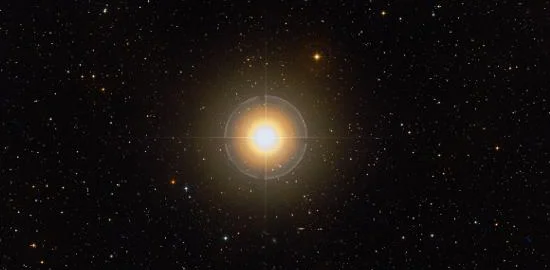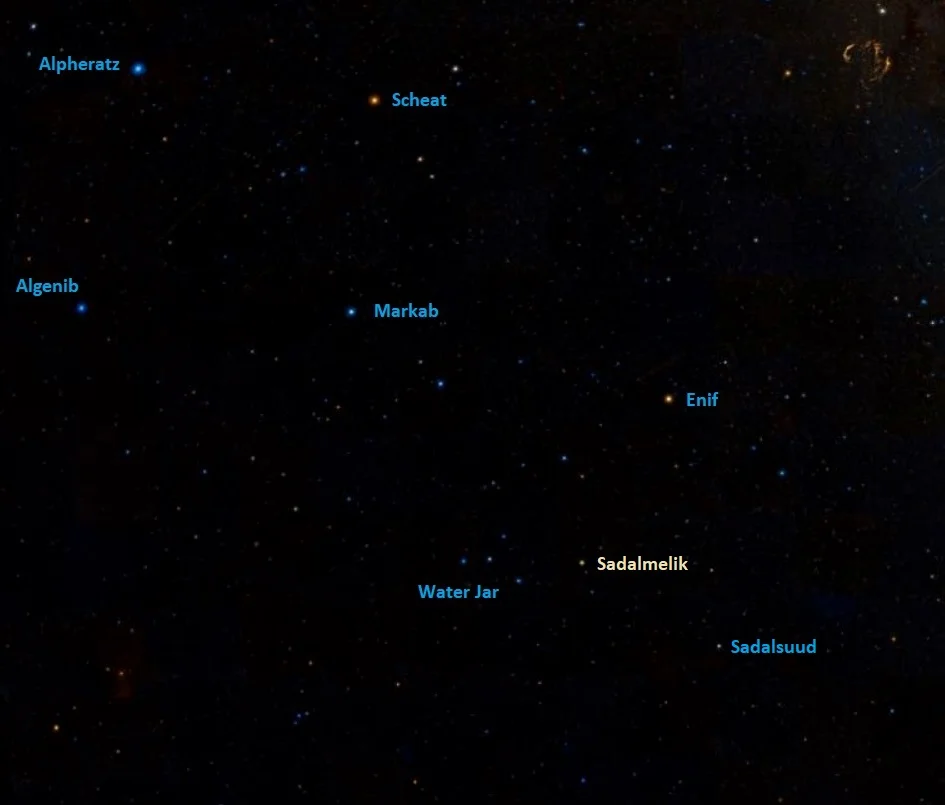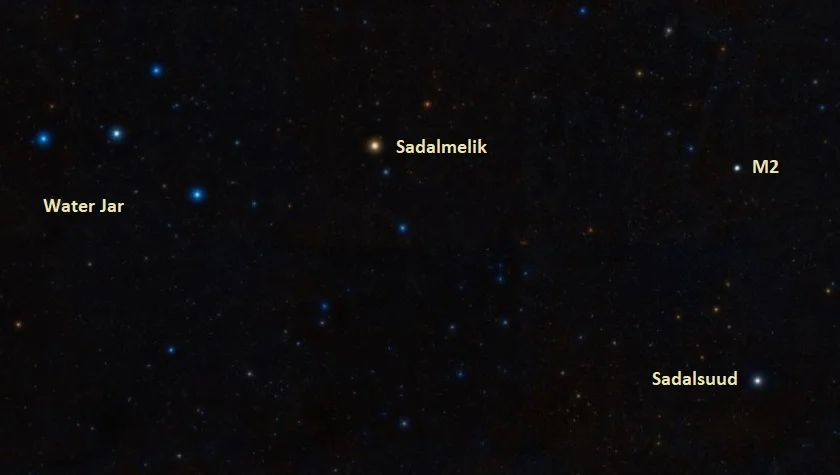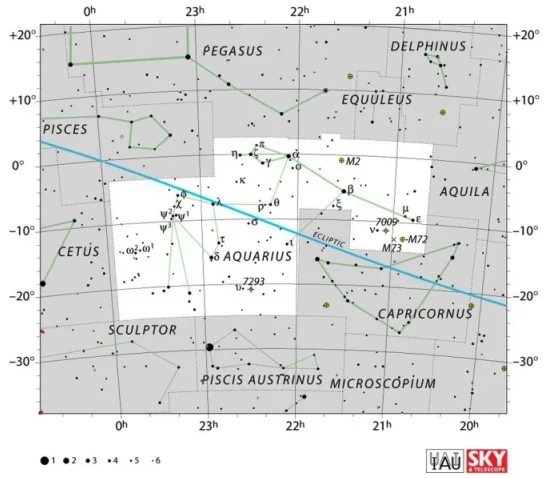Sadalmelik, Alpha Aquarii (α Aqr), is a yellow supergiant located in the constellation Aquarius. With an apparent magnitude of 2.942, it is the second brightest star in the constellation, after Sadalsuud. Sadalmelik lies at an approximate distance of 520 light years from Earth.
Star type
Sadalmelik is a yellow supergiant star of the spectral type G2 Ib. It has a mass 5.13 times that of the Sun and a radius 52.89 times solar. With a surface temperature of 5,383 K, it is 2,120 times more luminous than the Sun. The star is a relatively slow spinner, with a projected rotational velocity of 6.7 km/s. Its estimated age is 53 million years.
Facts
In 2005, a study using data collected with the Chandra X-ray Observatory reported the detection of coronal X-rays from Sadalmelik and its brighter neighbour Sadalsuud. This was the first definitive X-ray detection of coronal emissions from G-type supergiants. Both stars exhibit a striking X-ray deficiency, which is common among early G-type giants.

Sadalmelik (Alpha Aquarii), image: Wikisky
Sadalmelik, Sadalsuud (Beta Aquarii) and Enif (Epsilon Pegasi), the brightest star in the neighbouring constellation Pegasus, form an OB group. The stars’ space motions take them almost perpendicular to our galaxy’s plane. The three stars are not physically bound but were likely formed together in a loose cluster. The two Aquarius stars lie at similar distances and have similar properties. Both are class G supergiants about five times more massive than the Sun, 50 times larger, and more than 2,000 times more luminous. Enif is a cooler orange (K-type) supergiant over 150 light years more distant and much more luminous.
Sadalmelik is the primary component of a double star listed as WDS J22058-0019 A in the Washington Double Star Catalog (WDS). The Catalog of Components of Double & Multiple stars (CCDM) lists the secondary component as a star with an apparent magnitude of 12.2. Based on the data from Gaia Data Release 2, the companion has a radius 1.30 times that of the Sun and shines with 1.286 solar luminosities. It separated by 110.4 arcseconds from Sadalmelik. The star is catalogued as UCAC2 31789179 in the UCAC2 catalogue.
Name
The name Sadalmelik (pronunciation: /ˌsædəlˈmɛlɪk/) comes from the Arabic sa‘d al-malik, meaning “luck of the king.” Other versions of the name included Sadalmelek, Sadlamulk, Saad el Melik, and El Melik. The Arabic name was translated into Latin as Sidus Faustum Regis.
The name Sadalmelik was officially approved by the International Astronomical Union’s (IAU) Working Group on Star Names (WGSN) on August 21, 2016. It formally applies only to the component Alpha Aquarii A.
Alpha Aquarii was also historically known as Rucbah (from the Arabic word for “knee”). It shared the name with Ruchbah (Delta Cassiopeiae) and Rukbat (Alpha Sagittarii), which have the same origin.
In Chinese astronomy, Sadalmelik is known as 危宿一 (Wēi Xiù yī), the First Star of Rooftop. The Chinese Rooftop asterism is formed by Sadalmelik with Enif (Epsilon Pegasi) and Biham (Theta Pegasi). It is one of the northern mansions of the Black Tortoise.
Location
Sadalmelik is easy to find because it is both bright and located near two prominent asterisms, the Great Square of Pegasus and the Water Jar in Aquarius. The star appears just west of the Y-shaped Water Jar, close to the imaginary line extended from Eta Aquarii, the left star of the Y, through Zeta Aquarii, the central star of the asterism.

Sadalmelik location, image: Wikisky
Sadalmelik can also be found using the brighter, larger Great Square of Pegasus. It lies on a line drawn from Alpheratz, the top left star in the asterism, through Markab, the bottom right star.
Sadalmelik and Sadalsuud can be used to find the globular cluster Messier 2. The cluster lies five degrees north of Sadalsuud and forms a right-sided angle with the two supergiants. M2 has an apparent magnitude of 6.2 and an apparent size of 16’. It can be seen in binoculars. The cluster lies about 55,000 light years away. It is one of several globular clusters known to have once been part of the Gaia Sausage, a dwarf galaxy that merged with the Milky Way about 8 – 11 billion years ago. The estimated age of M2 is 13 billion years.

Sadalsuud, Sadalmelik and Messier 2, image: Wikisky
Constellation
Sadalmelik is located in the constellation Aquarius. Representing the celestial Water Bearer, Aquarius is one of the 48 ancient constellations catalogued by the Greek astronomer Ptolemy in the 2nd century CE.
Aquarius occupies an area of 980 square degrees of the (mostly southern) sky and is the 10th largest of all 88 constellations. Despite its size, it is not particularly conspicuous, since only its two brightest stars are brighter than magnitude 3.00.

Aquarius constellation map by IAU and Sky&Telescope magazine
Aquarius is known for its supergiants Sadalsuud and Sadalmelik, as well as for the Helix Nebula (NGC 7293), one of the brightest and best-known planetary nebulae in the sky. Other notable stars in the constellation include the triple star system Zeta Aquarii, the symbiotic star R Aquarii, and the binary systems Gamma Aquarii (Sadachbia) and Delta Aquarii (Skat). Aquarius is also home to a number of stars that host confirmed exoplanets. These include the red dwarfs TRAPPIST-1 with seven planets, Gliese 876 with four, and the orange giant 91 Aquarii, host to a planet discovered in 2003.
In addition to the Helix Nebula, bright deep sky objects in Aquarius include the globular clusters Messier 2 and Messier 72, the planetary nebula NGC 7009, also known as the Saturn Nebula, and the peculiar galaxy NGC 7252, nicknamed Atoms for Peace Galaxy. Aquarius is also home to the Aquarius Dwarf, a faint dwarf irregular galaxy in the Local Group.
The best time of year to observe the stars and deep sky objects in Aquarius is during the month of October, when the constellation reaches the highest point in the evening sky. The entire constellation is visible from locations between the latitudes 65° N and 90° S.
The 10 brightest stars in Aquarius are Sadalsuud (Beta Aqr, mag. 2.87), Sadalmelik (Alpha Aqr, mag. 2.942), Skat (Delta Aqr, mag. 3.28), Zeta Aquarii (mag. 3.65), 88 Aquarii (mag. 3.679), Lambda Aquarii (mag. 3.722), Albali (Epsilon Aqr, mag. 3.77), Sadachbia (Gamma Aqr, mag. 3.849), 98 Aquarii (mag. 3.97), and Eta Aquarii (mag. 4.04).
Sadalmelik – Alpha Aquarii
| Spectral class | G2 Ib |
| U-B colour index | +0.699 |
| B-V colour index | +0.971 |
| R-I colour index | +0.49 |
| Apparent magnitude | 2.942 |
| Absolute magnitude | –3.882 |
| Distance | 520 ± 20 light years (161 ± 5 parsecs) |
| Parallax | 6.23 ± 0.19 mas (Gaia: 12.9058 ± 0.8479 mas) |
| Radial velocity | 6.829 ± 0.0026 km/s |
| Proper motion | RA: +18.25 ± 0.24 mas/yr (Gaia: +30.965 ± 1.624 mas/yr) |
| Dec.: −9.39 ± 0.13 mas/yr (Gaia: -19.369 ± 1.491 mas/yr) | |
| Mass | 5.13 ± 0.06 M☉ |
| Luminosity | 2,120 ± 167 L☉ |
| Radius | 52.89 R☉ (51.11 – 54.57 R☉) |
| Temperature | 5,383 ± 74 K |
| Metallicity | +0.17 dex |
| Age | 53 million years |
| Rotational velocity | 6.7 ± 1.5 km/s |
| Surface gravity | 1.76 ± 0.04 cgs |
| Constellation | Aquarius |
| Right ascension | 22h 05m 47.0359315s |
| Declination | −00° 19′ 11.456766″ |
| Names and designations | Sadalmelik, Alpha Aquarii, α Aqr, 34 Aquarii, HD 209750, HR 8414, HIP 109074, FK5 827, SAO 145862, BD−01 4246, GC 30896, GCRV 13879, PPM 181401, AG-00 2832, JP11 3444, PLX 5332.00, IRAS 22032-0033, 2MASS J22054703-0019114, UBV 18874, TYC 5224-1806-1, Gaia DR2 2680356911815074432, CCDM J22058-0019A, IDS 22006-0048 A, WDS 22058-0019A |